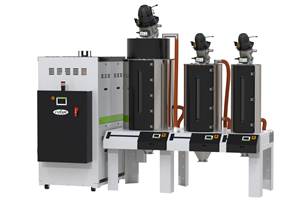Mobile Dry-Air Dryers for Small Throughputs Feature Integrated Conveying
By entering the material to be dried, the system automatically fills the drying bin and applies resin specific pre-drying conditions.
New, mobile dry-air dryers target moisture removal in hygroscopic plastics for small throughputs or stand-alone applications. Motan’s new Luxor E A and Luxor EM A are equipped with an installed drying bin and give processors 60, 100, or 150 liters of drying bin volume.
The Luxor E A models of the new range can be integrated into existing raw materials conveying systems or equipped with their own stand-alone material loader. Conversely, the Luxor EM A dryers with integrated conveying are self-contained mobile units. As standard, they have integrated dry-air drying and a side-channel blower, as well as a small, monitored cyclone dust-collection filter. The cyclone filter consists of a fine filter cartridge and a transparent dust-collection bin.
The dry-air conveying uses rigid-hose connections to ensure that the suction box is protected from ambient air and dry-air is always used for conveying. This is why material can remain in the suction box even during down times, as it continues to be in a dry environment and is protected from reabsorbing moisture.
The Luxor EM A version dryers with integrated conveying can control up to three Metro-G material loaders: one to supply the drying bin with material and up to two loaders for the processing machines. Optionally, Metro-G material loaders equipped with a Metromix proportioning valve can be installed, so that any regrind produced at the machine can be immediately returned to the production process. In order to adjust the amount of regrind, the proportioning valves are integrated into the central control at the dryer.
The dehumidified air dryers operate using a closed process cycle in combination with temperature-controlled regeneration. You can optionally also fit them with dew-point-controlled regeneration. The closed-cycle drying process means the dryers continue to produce process air with very low dew-points even when operating in very humid environments. The dryers have a compact footprint, with a depth of only 24 in.
New Control
Both dryer ranges are controlled and operated using the new LuxornetEM color touch-screen control. LuxornetEM controls drying and conveying for three material loaders, as well as recipe management, quality assurance reporting and enhanced service functions and trend charts. A weekly timer is also integrated.
Customers only need to select the material which is to be dried and start the system. Filling of the drying bin and the material specific pre-drying occurs automatically. The unit will then signal when the material is dried and production can be started.
The integrated Drying Organizer function monitors the amount of material being dried and guarantees material-protective drying results by adjusting the drying temperature. ETA plus airflow control with temperature adaptation is available as an option. To simplify the input of the material-related drying parameters such as drying time and temperature, a material database is integrated into the control. The database includes a data pool with parameters of approximately 70 standard materials and can accommodate an additional 50 data sets as specified by the customer.
The dryers can be integrated into existing central systems or linked together via Ethernet. In this way, all functions can also be operated from a superordinate system, and the drying system’s data can also be collected centrally.
Motan delivers the dryers pre-installed with all chosen options. All functions are previously tested in a factory setting and only the material loaders need to be set-up after delivery. After a short installation, the dry-air dryers are ready for use.
Related Content
AI Manages Resin Drying Airflows and Throughputs for Energy Savings
NPE2024: Optional feature automates the process of maintaining process-ready resins at perfect temperatures and varied throughputs, while preventing overdrying and realizing significant energy savings.
Read MoreFinding Efficiencies in How Components Work Together
Auxiliary systems are vital to the proper functioning of a plastic processing line, and they can be a source of major cost and efficiency improvements.
Read MoreOvercoming Drying Hopper Ambient Air Leaks
Consider using a compressed-air-operated discharge valve. This provides a positive seal when it closes and ensures that no wet ambient air seeps into the drying hopper.
Read MoreStreamlined Drying Process Speeds Up Changeovers
NPE2024: Maguire demonstrating increase in productivity possible by vacuum drying.
Read MoreRead Next
Beyond Prototypes: 8 Ways the Plastics Industry Is Using 3D Printing
Plastics processors are finding applications for 3D printing around the plant and across the supply chain. Here are 8 examples to look for at NPE2024.
Read MoreFor PLASTICS' CEO Seaholm, NPE to Shine Light on Sustainability Successes
With advocacy, communication and sustainability as three main pillars, Seaholm leads a trade association to NPE that ‘is more active today than we have ever been.’
Read More









